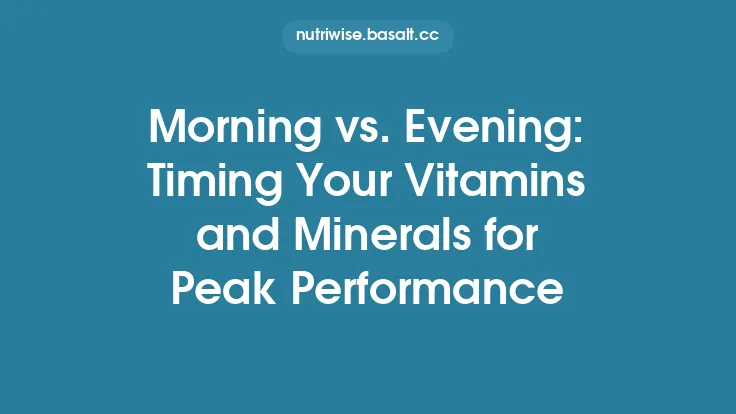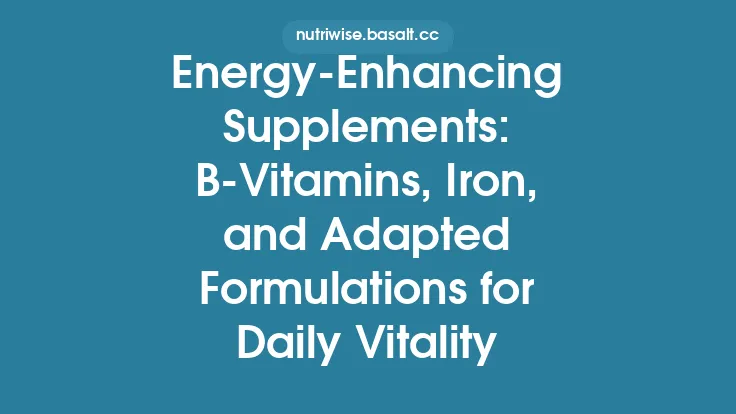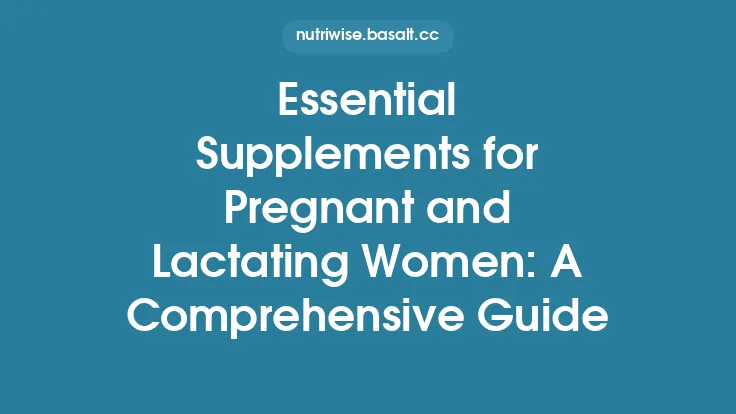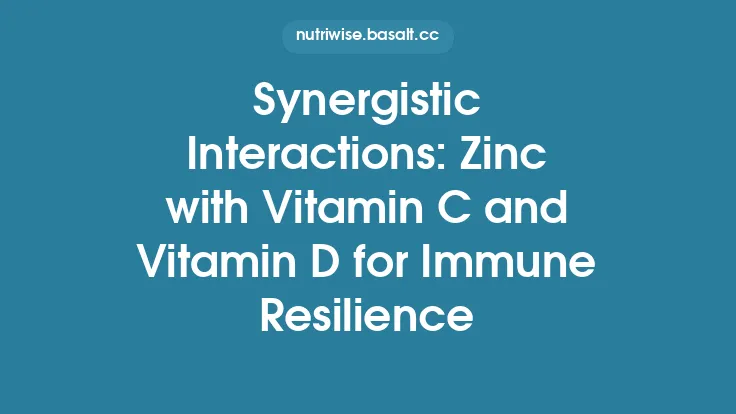When you think about taking a multivitamin, a fish‑oil capsule, or a vitamin‑C tablet, the first question that often comes to mind is “when should I take it?” The answer, however, is not a one‑size‑fits‑all. The chemistry that determines whether a nutrient dissolves in fat or water dictates how it travels through your gastrointestinal tract, which transport systems it uses, and which dietary companions will help—or hinder—its journey to the bloodstream. By aligning the timing of your supplement intake with the natural physiology of fat‑soluble and water‑soluble compounds, and by pairing them with the right co‑factors, you can markedly improve the proportion of the dose that actually reaches target tissues.
Understanding the Fundamental Differences in Solubility
Fat‑soluble nutrients (vitamins A, D, E, K and several phytonutrients such as carotenoids and co‑enzyme Q10) are lipophilic molecules. Their non‑polar structures make them poorly soluble in the aqueous environment of the stomach and small intestine. Consequently, they rely on the presence of dietary lipids to become incorporated into mixed micelles, which are then absorbed into enterocytes and packaged into chylomicrons for lymphatic transport.
Water‑soluble nutrients (the B‑vitamin complex, vitamin C, many minerals, and certain amino‑acid‑derived compounds) are polar or ionic. They dissolve readily in the watery milieu of the gastrointestinal lumen and are absorbed primarily via carrier‑mediated or active transport mechanisms directly into the portal circulation.
These intrinsic differences set the stage for distinct timing considerations and co‑factor requirements.
The Digestive Journey of Fat‑Soluble Compounds
- Emulsification – In the duodenum, bile salts act as natural surfactants, breaking down dietary fat droplets into smaller micelles. Without sufficient bile, micelle formation is inefficient, and fat‑soluble vitamins remain trapped in the lumen.
- Micellar Solubilization – The lipophilic nutrient partitions into the core of the micelle, becoming water‑dispersible enough to approach the brush‑border membrane of enterocytes.
- Enterocyte Uptake – Fat‑soluble vitamins are taken up by passive diffusion or, for some (e.g., vitamin E), by specific transport proteins such as NPC1L1.
- Chylomicron Incorporation – Inside the enterocyte, the vitamin is re‑esterified (if necessary) and packaged with triglycerides, phospholipids, and apolipoproteins into chylomicrons.
- Lymphatic Transport – Chylomicrons bypass the portal vein, entering the lymphatic system and eventually the systemic circulation via the thoracic duct. This route explains why peak plasma levels of fat‑soluble vitamins often appear 4–8 hours after ingestion, rather than immediately.
The Pathway of Water‑Soluble Nutrients
- Aqueous Dissolution – Because they are already soluble, these nutrients remain in solution throughout gastric emptying.
- Carrier‑Mediated Absorption – Specific transporters (e.g., SLC5A8 for thiamine, SLC23A1 for vitamin C) facilitate uptake across the apical membrane of enterocytes.
- Portal Vein Delivery – Once inside the cell, water‑soluble nutrients enter the portal circulation directly, reaching the liver first.
- First‑Pass Metabolism – The liver can store, transform, or release the nutrient into systemic circulation. For many B‑vitamins, hepatic storage is limited, so plasma concentrations rise quickly (within 30 minutes to 2 hours) after ingestion.
Practical Timing Strategies for Fat‑Soluble Supplements
| Situation | Recommended Timing | Rationale |
|---|---|---|
| Standard multivitamin containing A, D, E, K | With a main meal that provides 5–10 g of dietary fat (e.g., eggs, avocado, nuts, olive oil) | Adequate fat triggers bile release, maximizes micelle formation, and ensures chylomicron assembly. |
| High‑dose vitamin D3 (≥ 5,000 IU) | Split across two meals containing fat, or taken with a fat‑rich snack (e.g., Greek yogurt with berries) | Large single doses can saturate micellar capacity; spreading intake improves overall absorption. |
| Oil‑based softgel (e.g., fish oil, CoQ10) | Immediately after a meal that includes fat, not before | Gastric emptying is delayed by food, allowing the oil to mix with bile‑rich chyme. |
| Carotenoid supplements (β‑carotene, lutein) | With a fat‑containing breakfast or lunch; avoid taking on an empty stomach | Carotenoids are highly lipophilic; even modest fat (≈ 3 g) dramatically raises plasma levels. |
| Vitamin K2 (MK‑7) for bone health | With the evening meal that includes some fat, especially if calcium‑rich foods are consumed | MK‑7’s long half‑life benefits from steady, low‑grade absorption; evening dosing aligns with nocturnal bone remodeling. |
Key tip: If you are on a low‑fat diet (e.g., ketogenic or very low‑calorie regimens), consider fortified emulsified powders or liposomal formulations that pre‑package the vitamin in a micelle‑like structure, bypassing the need for dietary fat.
Practical Timing Strategies for Water‑Soluble Supplements
| Situation | Recommended Timing | Rationale |
|---|---|---|
| B‑vitamin complex (B1, B2, B3, B5, B6, B7, B9, B12) | 30 minutes before a light meal or mid‑morning on an empty stomach | An aqueous environment without competing nutrients promotes rapid carrier‑mediated uptake. |
| Vitamin C (ascorbic acid) | Morning on an empty stomach, or between meals | Acidic pH enhances solubility; taking with food can reduce gastrointestinal irritation for sensitive individuals. |
| Magnesium citrate (water‑soluble form) | Before bedtime after a light snack | Magnesium can have a mild laxative effect; nighttime dosing minimizes interference with daytime activities. |
| Iron (ferrous sulfate) | Empty stomach with a source of vitamin C (e.g., orange juice) | Vitamin C reduces ferric to ferrous iron, dramatically increasing absorption. |
| Electrolyte powders (sodium, potassium) | During or after exercise, mixed in water | Immediate dissolution ensures rapid plasma replenishment. |
Caution: While many water‑soluble vitamins are well tolerated on an empty stomach, some individuals experience nausea. In such cases, a small amount of food (e.g., a piece of fruit) can be added without substantially compromising absorption.
Co‑Factors That Amplify Fat‑Soluble Uptake
- Dietary Fat Quality – Long‑chain triglycerides (LCTs) from animal fats, coconut oil, or olive oil are more effective at stimulating bile release than medium‑chain triglycerides (MCTs). However, MCTs still provide a useful “fat trigger” for those on very low‑fat diets.
- Bile Acids – For individuals with compromised bile production (e.g., after gallbladder removal), a low‑dose bile‑salt supplement (e.g., ox bile) taken with the fat‑soluble vitamin can restore micelle formation.
- Vitamin D–Calcium Synergy – Calcium enhances the intestinal absorption of vitamin D by stabilizing the micellar environment; a modest calcium source (≈ 200 mg) with vitamin D can improve uptake.
- Vitamin E–Vitamin C Interaction – Vitamin C regenerates oxidized vitamin E, preserving its antioxidant capacity. Taking vitamin C within 1 hour of vitamin E can sustain functional activity, though it does not affect absorption per se.
- Vitamin K2–Vitamin D3 Pairing – Vitamin D up‑regulates the synthesis of vitamin K‑dependent proteins; co‑administering K2 ensures those proteins are carboxylated, optimizing calcium deposition in bone rather than arteries.
Co‑Factors That Boost Water‑Soluble Absorption
| Nutrient | Co‑Factor | Mechanism |
|---|---|---|
| Iron | Vitamin C (ascorbic acid) | Reduces Fe³⁺ to Fe²⁺, a form readily transported by DMT1 (divalent metal transporter‑1). |
| Vitamin B12 | Intrinsic factor (produced in the stomach) | Binds B12 to form a complex that is absorbed in the ileum via the cubilin receptor. |
| Folate (B9) | Vitamin B12 | B12 is required for the regeneration of tetrahydrofolate, enhancing folate utilization after absorption. |
| Magnesium | Vitamin D | Vitamin D up‑regulates intestinal TRPM6 channels, facilitating magnesium uptake. |
| Zinc | Protein (e.g., whey) or amino acids | Amino‑acid complexes prevent zinc precipitation and improve transporter affinity. |
When planning a supplement regimen, consider pairing these nutrients within the same dosing window to exploit the synergistic transport mechanisms.
Formulation Matters: How Delivery Systems Influence Bioavailability
- Liposomal Encapsulation – Encases the nutrient in a phospholipid bilayer, mimicking a micelle. This can dramatically increase the absorption of both fat‑soluble (e.g., vitamin D) and water‑soluble (e.g., vitamin C) compounds, especially when dietary fat is limited.
- Emulsified Powders – Pre‑mixed with emulsifiers (lecithin, polysorbate‑80) to create stable oil‑in‑water droplets. These are particularly useful for carotenoids and co‑enzyme Q10.
- Softgel Capsules – Provide a lipid matrix that dissolves readily in the presence of bile, making them ideal for oils and fat‑soluble vitamins.
- Enteric‑Coated Tablets – Protect acid‑labile water‑soluble vitamins (e.g., B12) from gastric degradation, releasing them in the more neutral pH of the small intestine where specific transporters are abundant.
- Sublingual Sprays/Tinctures – Bypass the gastrointestinal tract entirely, delivering water‑soluble nutrients directly into the systemic circulation via the oral mucosa. This route is useful for rapid vitamin B12 replenishment.
Choosing a formulation that aligns with your dietary pattern (e.g., low‑fat vs. high‑fat) can reduce the need for strict timing adjustments.
Common Pitfalls and How to Avoid Them
- Taking Fat‑Soluble Vitamins on an Empty Stomach – Without dietary fat, micelle formation is suboptimal, leading to < 30 % absorption for many vitamins. Pair with at least a teaspoon of oil or a fatty food.
- Consuming Large Doses of Vitamin E with Coffee – Caffeine can increase bile flow but also accelerates intestinal transit, reducing contact time for micelle formation. Space coffee at least 30 minutes away from the vitamin.
- Stacking Multiple High‑Dose Water‑Soluble Vitamins – Excess B‑vitamins compete for the same transporters (e.g., thiamine and riboflavin share the SLC19A2 transporter), potentially limiting each other's uptake. Stagger doses across the day.
- Neglecting Co‑Factor Pairings – Taking iron without vitamin C, or vitamin D without calcium, can blunt the expected rise in plasma levels. Include the co‑factor in the same meal or supplement mix.
- Relying Solely on “Fast‑Acting” Forms – Some “instant‑release” formulations of fat‑soluble vitamins are actually oil‑free powders that dissolve poorly. Opt for emulsified or liposomal versions if you cannot guarantee a fatty meal.
Putting It All Together: A Sample Daily Schedule
| Time | Action | Rationale |
|---|---|---|
| 07:30 am | Light breakfast (e.g., oatmeal with a handful of walnuts) | Provides ~ 5 g of fat to support a multivitamin containing A, D, E, K. |
| 08:00 am | B‑vitamin complex (water‑soluble) on an empty stomach | Maximizes carrier‑mediated uptake before food slows gastric emptying. |
| 10:30 am | Vitamin C tablet with a glass of water | Acidic environment still present; no competing nutrients. |
| 12:30 pm | Lunch with avocado and olive oil dressing | Fat content triggers bile for carotenoid supplement taken with the meal. |
| 02:00 pm | Iron (ferrous sulfate) + orange juice (vitamin C) | Vitamin C reduces iron, enhancing absorption. |
| 06:00 pm | Dinner containing salmon (rich in omega‑3) and a side of leafy greens | Fish‑oil softgel taken with the meal; dietary fat ensures micelle formation. |
| 07:30 pm | Vitamin D3 (5,000 IU) + calcium‑rich yogurt | Calcium stabilizes micelles; evening dosing aligns with nocturnal bone remodeling. |
| 09:00 pm | Magnesium citrate (water‑soluble) with a small snack | Nighttime dosing supports relaxation and avoids daytime GI upset. |
This schedule illustrates how a single day can accommodate both solubility classes, respect their distinct timing windows, and incorporate essential co‑factors—all without requiring complex calculations or excessive meal planning.
By recognizing that the solubility of a supplement dictates its physiological pathway, you can strategically align intake with the body’s natural digestive cues. Pairing fat‑soluble vitamins with modest dietary fat, ensuring the presence of bile or bile‑salt aids, and coupling water‑soluble nutrients with their specific co‑factors (like vitamin C for iron) transforms a routine supplement regimen into a finely tuned system for optimal nutrient delivery. The result is not just higher plasma concentrations, but more efficient utilization of the nutrients you invest in—leading to better health outcomes over the long term.





